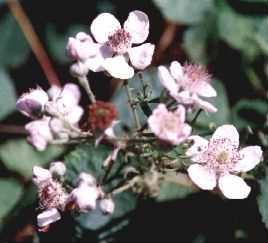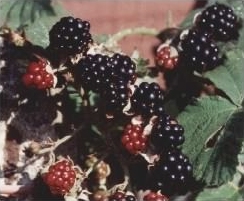

rk.jpg)
Click for a larger image
Photo ©1999
University of Wisconsin Madison
Bramble - Rubus fruticosus agg.
Family - Rosaceae
Commonly known as Blackberry
Widespread and well known shrub in Britain and Continental Europe growing to 3m (10ft) high producing a soft bodied fruit popular for making jams and sometimes wine. A very variable species composed of many sub–species with a scrambling habit of dense arching stems carrying short curved very sharp spines, the branches rooting from the tip node when they reach the ground. Very pervasive, growing at fast daily rates in woods, scrub, hillsides and hedgerows, colonising large areas in a relatively short time. It will tolerate poor soil and is an early coloniser of wasteland and building sites. Palmate leaves of three to five leaflets with flowers of white or pink appearing from May to August, ripening to a black or dark purple multi–lobed aggregated fruit composed of drupelets, the "Blackberries". Fruit is similar to Raspberry but larger, Raspberry is red in colour and "daintier". To distinguish Blackberry from Raspberry, when picked the torus, the centre receptacle or stem part of the fruit, stays with Blackberry, with Raspberry the torus remains on the plant leaving a hollow centre to the fruit.
Used for pies, wine, jam and jellies, superstition holds that Blackberries should not be picked after September 29th (Michaelmas) as the Devil has claimed them, having left his mark on the leaves. Related to the smaller R. caesius which produces a white waxy coating on the fruits. It is not advisable to use or eat Blackberries growing close to roadsides due to the accumulation of various toxins from passing traffic, Eg. smoke particles, road dirt, oil, diesel and glycol.
 |
 |
rk.jpg) Click for a larger image Photo ©1999 University of Wisconsin Madison |
| Two photos above ©2001– | ||
Site design ©1999– Brickfields Country Park - Privacy -